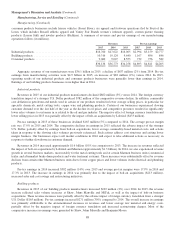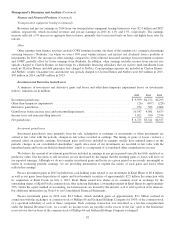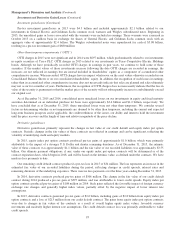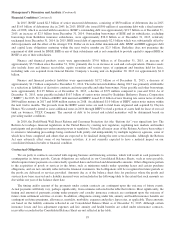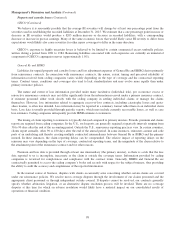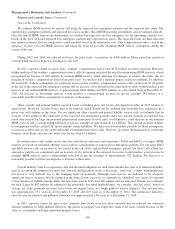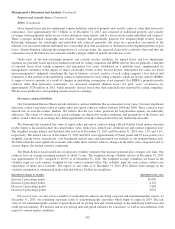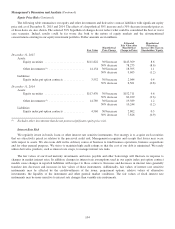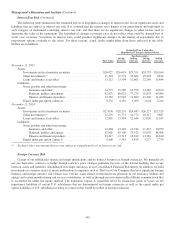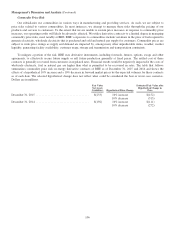Berkshire Hathaway 2015 Annual Report Download - page 99
Download and view the complete annual report
Please find page 99 of the 2015 Berkshire Hathaway annual report below. You can navigate through the pages in the report by either clicking on the pages listed below, or by using the keyword search tool below to find specific information within the annual report.Management’s Discussion and Analysis (Continued)
Property and casualty losses (Continued)
Reinsurance receivables are recorded for losses recoverable from third parties and are estimated in a manner similar to
liabilities for insurance losses. Reinsurance receivables may ultimately prove to be uncollectible if the reinsurer is unable to
perform under the contract. Reinsurance contracts do not relieve the ceding company of its obligations to indemnify its own
policyholders. Additional information regarding those processes and techniques of our significant insurance businesses
(GEICO, General Re and BHRG) follows.
GEICO
GEICO predominantly writes private passenger auto insurance. GEICO’s gross unpaid losses and loss adjustment expense
liabilities as of December 31, 2015 were $13.7 billion compared to $12.2 billion as of December 31, 2014.
GEICO’s claim reserving methodologies produce liability estimates based upon the individual claims (or a “ground-up”
approach), which yield an aggregate estimate of the ultimate losses and loss adjustment expenses. The key assumptions affecting
our reserve estimates include projections of ultimate claim counts (“frequency”) and average loss per claim (“severity”).
We establish and evaluate unpaid loss liabilities using standard actuarial loss development methods and techniques. The
significant components of recorded liabilities at December 31, 2015 included $9.7 billion of reported average, case and case
development reserves and $4.0 billion of IBNR reserves. Our recorded liabilities are affected by the expected frequency and
average severity of claims. We use statistical techniques to analyze historical claims data and adjust when appropriate to reflect
perceived changes in loss patterns. We analyze claims data a number of ways, including by rated state, reporting date and
occurrence date.
We establish average reserves for reported new auto damage and liability claims prior to the development of an individual
case reserve. Average reserves represent our estimated liabilities for claims when our adjusters have insufficient time and
information to make specific claim estimates and for a large number of relatively minor physical damage claims that are paid
within a relatively short time after being reported. Aggregate average reserves are driven by the estimated average severity per
claim and the number of new claims opened.
We generally establish individual liability claim case loss reserve estimates once the facts and merits of each claim are
evaluated. Case reserves represent the amounts that in the judgment of the adjusters are reasonably expected to be paid to
completely settle the claim, including expenses. Individual case reserves are revised over time as information becomes available.
Approximately 92% of GEICO’s claim liabilities as of December 31, 2015 related to automobile liability coverages, of
which bodily injury (“BI”) coverage accounted for approximately 55%. Liability estimates for automobile liability coverages
(such as BI, uninsured motorists, and personal injury protection) are more uncertain due to the longer claim-tails, the greater
chance of protracted litigation, and the incompleteness of facts available at the time the case reserve is first established. Case
reserves alone insufficiently measure the ultimate claim cost, so we establish additional case development reserve estimates,
which are usually percentages of the case reserves. As of December 31, 2015, case development reserves averaged
approximately 25% of the case reserves. Case development factors are selected by a retrospective analysis of the overall
adequacy of historical case reserves and are reviewed and revised periodically.
For unreported claims, IBNR reserves are estimated by first projecting the ultimate number of claims expected (reported
and unreported) for each significant coverage. We use historical quarterly and monthly claim counts to develop age-to-age
projections of the ultimate counts by accident quarter. Reported claims are deducted from the ultimate claim projections to
produce an estimate of the number of unreported claims. The number of estimated unreported claims is then multiplied by an
estimate of the average cost per unreported claim to produce the IBNR reserve amount. Actuarial techniques are difficult to
apply reliably in certain situations, such as new or changing legal precedents, class action suits or recent catastrophes.
Consequently, we may establish supplemental IBNR reserves in these situations.
For significant coverages, we test the adequacy of the aggregate liabilities for unpaid losses using one or more actuarial
projections based on claim closure models, paid loss triangles and incurred loss triangles. Each type of projection analyzes loss
occurrence data for claims occurring in a given period and projects the ultimate cost.
Unpaid loss and loss adjustment expense liability estimates recorded at the end of 2014 developed downward by $147
million when reevaluated through December 31, 2015. The downward revisions produced a corresponding increase to pre-tax
earnings in 2015, which was approximately 0.7% of earned premiums and 1.3% of prior year-end recorded net liabilities. In
2014, estimated liabilities for pre-2014 occurrences developed downward $386 million or 3.6% of net liabilities at
December 31, 2013. Assumptions used to estimate liabilities at December 31, 2015 were modified as appropriate to reflect the
most recent frequency and severity results. Future development of recorded liabilities will depend on whether actual frequency
and severity are more or less than anticipated.
97



